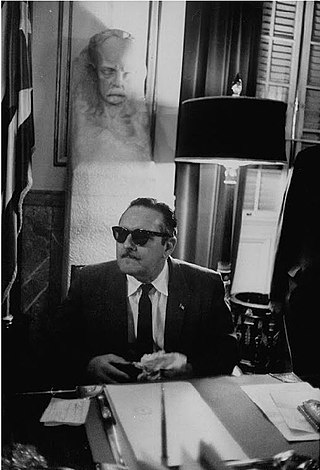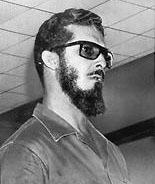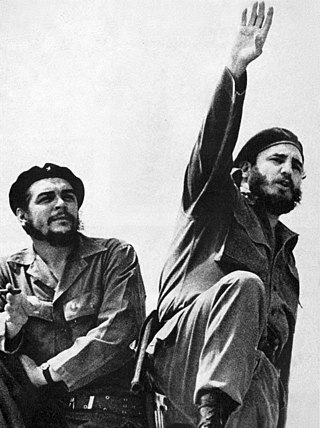| |||||
| Decades: | |||||
|---|---|---|---|---|---|
| See also: | |||||
The following lists events that happened during 1959 in Cuba .
| |||||
| Decades: | |||||
|---|---|---|---|---|---|
| See also: | |||||
The following lists events that happened during 1959 in Cuba .

Fulgencio Batista y Zaldívar was a Cuban military officer and politician who served as the elected president of Cuba from 1940 to 1944 and as its U.S.-backed military dictator from 1952 to 1959, until he was overthrown in the Cuban Revolution.

The Cuban Revolution was a military and political effort to overthrow the government of Cuba between 1953 and 1959. It began after the 1952 Cuban coup d'état which placed Fulgencio Batista as head of state and the failed mass strike in opposition that followed. After failing to contest Batista in court, Fidel Castro organized an armed attack on the Cuban military's Moncada Barracks on July 26th, 1953. The rebels were arrested and while in prison formed the 26th of July Movement. After gaining amnesty the M-26-7 rebels organized an expedition from Mexico on the Granma yacht to invade Cuba. In the following years the M-26-7 rebel army would slowly defeat the Cuban army in the countryside, while its urban wing would engage in sabotage and rebel army recruitment. Over time the originally critical and ambivalent Popular Socialist Party would come to support the 26th of July Movement in late 1958. By the time the rebels were to oust Batista the revolution was being driven by the Popular Socialist Party, 26th of July Movement, and the Directorio Revolucionario Estudiantil.

The 26th of July Movement was a Cuban vanguard revolutionary organization and later a political party led by Fidel Castro. The movement's name commemorates the failed 1953 attack on the Moncada Barracks in Santiago de Cuba, part of an attempt to overthrow the dictator Fulgencio Batista.

The Moncada Barracks were military barracks in Santiago de Cuba, Cuba named after General Guillermo Moncada, a hero of the Cuban War of Independence. On 26 July 1953, the barracks was the site of an armed attack by a small group of revolutionaries led by Fidel Castro. That day a simultaneous attack was carried out on the Carlos M. de Cespedes Barracks in Bayamo directed by Raúl Martínez Ararás by order of Castro. The attack failed and the surviving revolutionaries were imprisoned. This armed attack is widely accepted as the beginning of the Cuban Revolution. The date on which the attack took place, 26 July, was adopted by Castro as the name for his revolutionary movement which eventually toppled the dictatorship of Fulgencio Batista on 1 January 1959.

Osvaldo Dorticós Torrado was a Cuban politician who served as the president of Cuba from 1959 to 1976. He was a close ally of Cuban revolutionary and longtime leader Fidel Castro.

Manuel Urrutia Lleó was a liberal Cuban lawyer and politician. He campaigned against the Gerardo Machado government and the dictatorial second presidency of Fulgencio Batista during the 1950s, before serving as president in the revolutionary government of 1959. Urrutia resigned his position after only seven months, owing to a series of disputes with revolutionary leader Fidel Castro, and emigrated to the United States shortly afterward.
Carlos Manuel Piedra y Piedra (1895–1988) was a Cuban politician who served as the Interim President of Cuba for a single day during the transition of power between Fulgencio Batista and revolutionary leader Fidel Castro in the Cuban Revolution. Piedra was appointed interim president by a junta led by Eulogio Cantillo in accordance with the 1940 Cuban Constitution. Piedra had previously been the eldest judge of the Supreme Court. The appointment of Piedra, the last president to be born under Spanish Cuba, was met with opposition from Castro, who believed that Manuel Urrutia should be appointed.

Huber Matos Benítez was a Cuban military leader, political dissident, activist, and writer. He opposed the dictatorship of Fulgencio Batista from its inception in 1952 and fought alongside Fidel Castro, Raul Castro, Che Guevara, Camilo Cienfuegos and other members of the 26th of July Movement to overthrow it. Following the success of the Cuban Revolution that brought Fidel Castro to power, he criticized the regime's shift in favor of Marxist principles and ties to the Popular Socialist Party (PSP). Convicted of treason and sedition by the revolutionary government, he spent 20 years in prison (1959–1979) before being released in 1979. He then divided his time between Miami, Florida, and Costa Rica while continuing to protest the policies of the Cuban government.

Carlos Hevia y de los Reyes-Gavilan was the interim President of Cuba, serving for less than three days. During the third week of 1934, Hevia was President from 5:00 p.m. on Monday, January 15, until 1:20 a.m. on Thursday, January 18. Cuban junta leader Fulgencio Batista had obtained the resignation of Hevia's predecessor, Ramón Grau. The choice of Hevia was unpopular with the military, and by Wednesday, the new President was asked to resign. He was replaced by Manuel Márquez Sterling.
The Cuban Revolution was the overthrow of Fulgencio Batista's regime by the 26th of July Movement and the establishment of a new Cuban government led by Fidel Castro in 1959.

Ramón M. Barquín was a Cuban military colonel and opponent of former President Fulgencio Batista. Barquín was jailed by the Batista government for leading a failed coup attempt in 1956. He later fled Cuba in 1960 following the 1959 takeover by Fidel Castro.

Marta Fernández Miranda de Batista aka Marta del Pueblo was First Lady of Cuba from 1952 until 1959. She was the second wife of Cuban President Fulgencio Batista, who was overthrown by Fidel Castro in the 1959 Cuban Revolution, which forced the couple to flee permanently into exile.

The following events occurred in January 1959:
Humberto Sorí Marín was a Cuban revolutionary. After the Cuban Revolution in January 1959, he served as minister of agriculture, but resigned in May 1959. Shortly before the Bay of Pigs Invasion, he was arrested after landing in Cuba with arms and explosives, and was executed after the invasion.

The University of Havana is a university located in the Vedado district of Havana, the capital of the Republic of Cuba. Founded on January 5, 1728, the university is the oldest in Cuba, and one of the first to be founded in the Americas. Originally a religious institution, today the University of Havana has 15 faculties (colleges) at its Havana campus and distance learning centers throughout Cuba.

Eulogio Cantillo Porras was a general in the Cuban Army. General Cantillo served as Chief of the Joint Staff during the dictatorship of Fulgencio Batista, but did not participate in the military coup that brought Batista to power. During the Cuban Revolution, he led Cuban soldiers in the fight against Fidel Castro's 26th of July Movement. After President Batista fled the country at 3:00 A.M. on January 1, 1959, he was left to serve briefly as the de facto Head of State in the early hours of January 1, 1959 until the official proclamation of the President of the Senate of Cuba, Anselmo Alliegro y Milá, as the Interim President of Cuba later that day. On January 2, 1959, the eldest judge of the Supreme Court, Carlos Manuel Piedra, was appointed as the Interim President by a junta led by him in accordance with the 1940 Cuban Constitution. However, the appointment of Piedra, the last president to be born under Spanish Cuba, was met with opposition from Castro, who believed that Manuel Urrutia should be appointed. After the Cuban Revolution, he was tried by the Revolutionary tribunals and sentenced to 15 years in prison. He was released early in the mid-1960s, and went into exile in Miami where he died on September 9, 1978.
The Cuban communist revolutionary and politician Fidel Castro took part in the Cuban Revolution from 1953 to 1959. Following on from his early life, Castro decided to fight for the overthrow of Fulgencio Batista's military junta by founding a paramilitary organization, "The Movement". In July 1953, they launched a failed attack on the Moncada Barracks, during which many militants were killed and Castro was arrested. Placed on trial, he defended his actions and provided his famous "History Will Absolve Me" speech, before being sentenced to 15 years' imprisonment in the Model Prison on the Isla de Pinos. Renaming his group the "26th of July Movement" (MR-26-7), Castro was pardoned by Batista's government in May 1955, claiming they no longer considered him a political threat while offering to give him a place in the government, but he refused. Restructuring the MR-26-7, he fled to Mexico with his brother Raul Castro, where he met with Argentine Marxist-Leninist Che Guevara, and together they put together a small revolutionary force intent on overthrowing Batista.

Augusto Martínez Sánchez was a Cuban lawyer and politician, and one of the commanders of the Cuban Revolution close to Fidel Castro. Martínez Sánchez was a member of the July 26 Movement since April 1958 and participated in the guerrilla struggle in the Sierra Maestra against the government of Fulgencio Batista, attached to the Second Eastern Front "Frank País", under the direct orders of Raúl Castro.

The consolidation of the Cuban Revolution is a period in Cuban history typically defined as starting in the aftermath of the revolution in 1959 and ending in the first congress of the Communist Party of Cuba 1975, which signified the final political solidification of the Cuban revolutionaries' new government. The period encompasses early domestic reforms, human rights violations continuing under the new regime, growing international tensions, and politically climaxed with the failure of the 1970 sugar harvest.